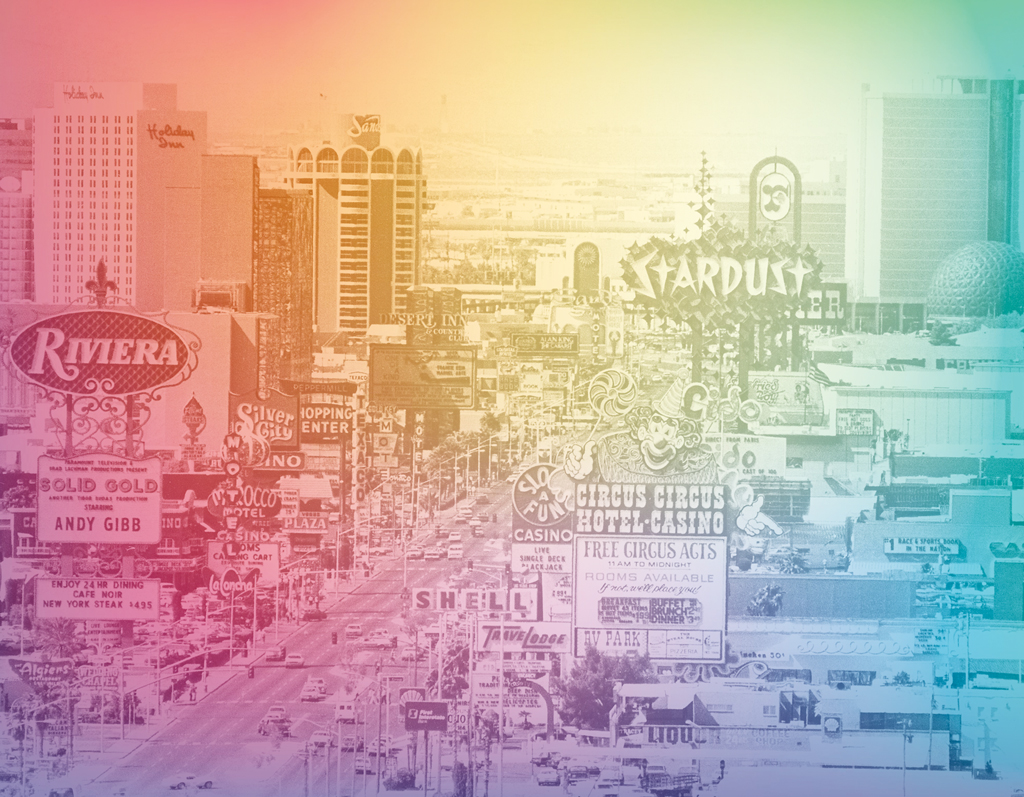[ad_1]
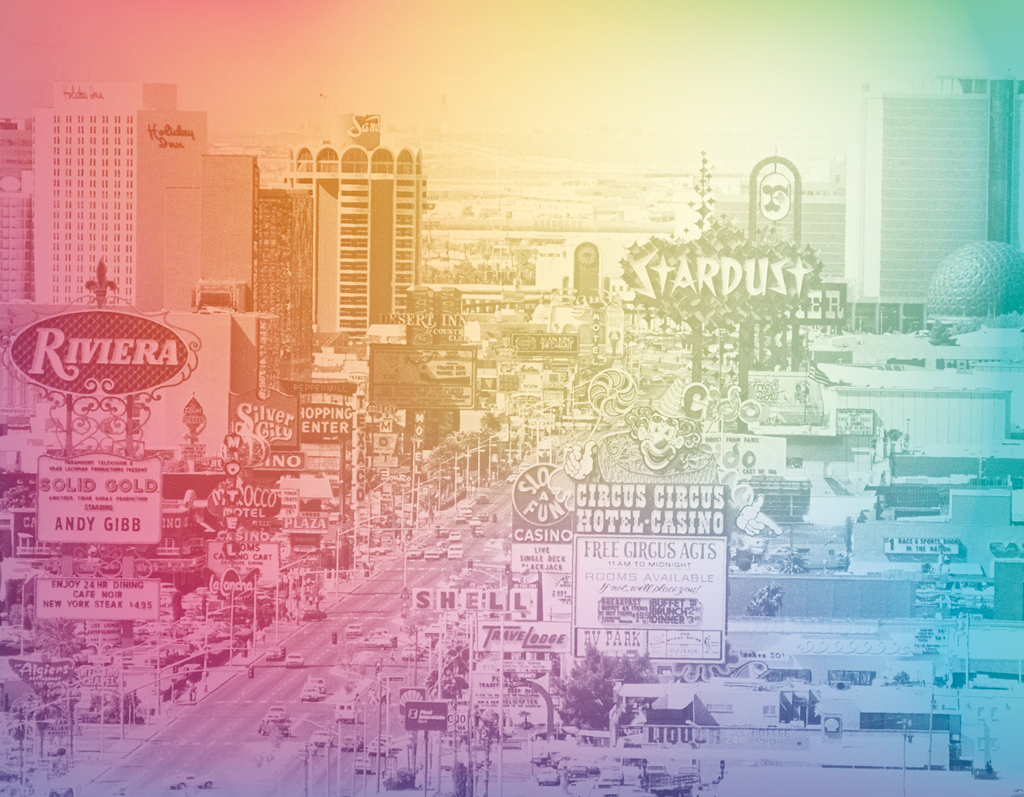
A place defined by numerous forms of entertainment, Las Vegas has long lacked a major art museum.
LAS VEGAS NEWS BUREAU, LAS VEGAS CONVENTION AND VISITORS AUTHORITY
There are many arts for which Las Vegas is known. Contemporary art is not among them. The city has museums devoted to the Mob, and to its own famous neon signage, but it lacks a world-class art museum. When artist Wendy Kveck led school tours through the Guggenheim art collection formerly housed at the Venetian Resort, what bothered her most was not navigating kindergarten-through-12th-graders through a casino, but what she discovered about the kids’ experience of art: “Many of my students had never been to an art museum in their entire life,” she says.
After decades of teasing and flirting, though, smart money is betting in favor of efforts to build an ambitious contemporary art museum in Las Vegas. There’s funding in the state budget, a matching grant of downtown land and cash from the city, a search for an architect is underway—led by Richard Koshalek, former longtime director of the Museum of Contemporary Art, Los Angeles—and a newly arrived, well-connected director is gearing up a fund-raising effort that will involve naming rights.
The move could see America’s most notorious city join Des Moines, Omaha, Fort Worth, and other midsize cities in having a boundary-pushing art museum. It would follow an era of hope that fizzled even as casinos hosted megawatt art collections from the Guggenheim and the Smithsonian to draw tourists to the Las Vegas Strip.
“Vegas has been the entertainment capital of the world, and it has been daunting to introduce a bona fide cultural institution into this energized mix,” says David Walker, director of the Nevada Museum of Art in Reno. The new Las Vegas museum is being developed with the well-established Reno institution, forming a creative bridge between northern and southern Nevada.
The Reno partnership has been integral to establishing credibility for these Las Vegas plans after a short-lived entity known as the Las Vegas Museum of Art, led by then director Libby Lumpkin, shuttered in 2009 for lack of funding.
The particular dynamics of Las Vegas worked against that effort, says Lumpkin, now a professor in the University of New Mexico’s department of art. She struggled to raise significant support for the tiny museum, located in part of the local public library in a suburb called Summerlin, in a city whose major art collectors included Steve Wynn and his wife at the time, Elaine, a company co-founder and now a trustee of the Los Angeles County Museum of Art. “In Las Vegas, the foot that falls into a museum does not fall into a casino,” Lumpkin says.
“It was a very bitter end,” says Walker.
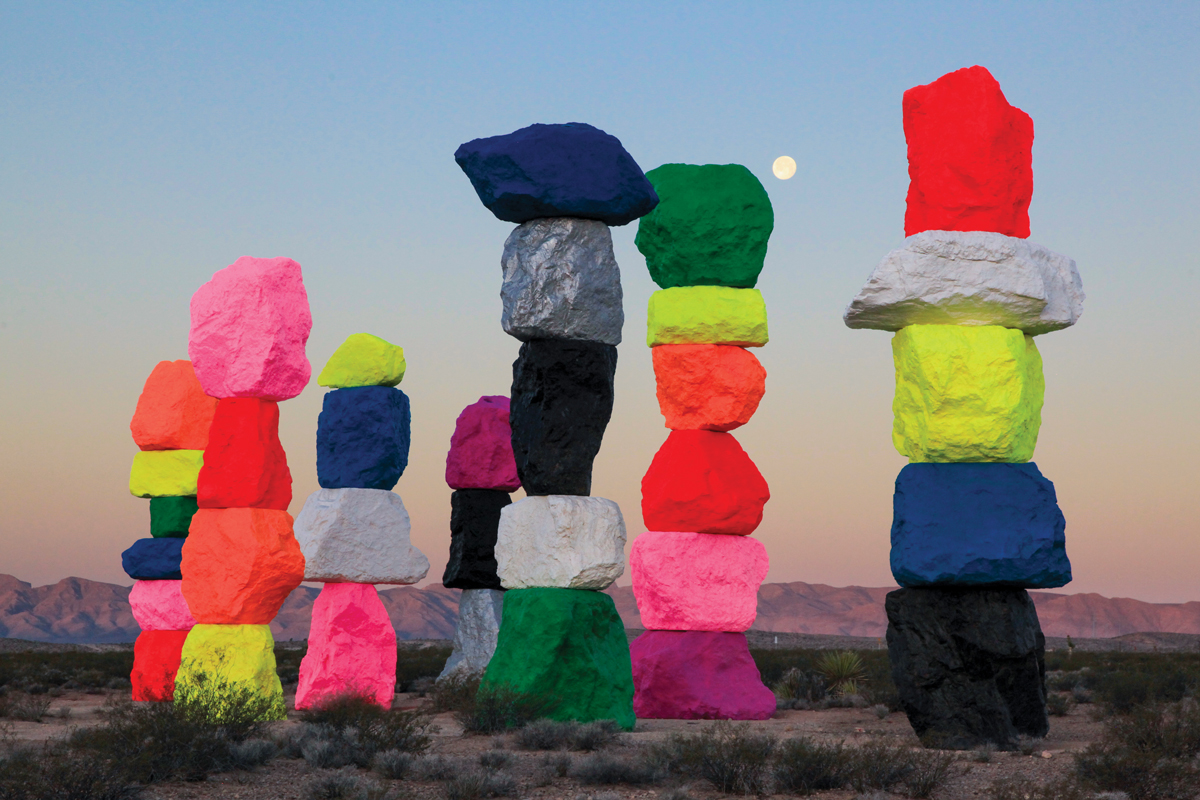
Ugo Rondinone’s Seven Magic Mountains, 2016, draws roughly 1,000 visitors a day to a remote spot in the desert about 10 miles south of Las Vegas.
GIANFRANCO GORGONI/COURTESY ART PRODUCTION FUND AND NEVADA MUSEUM OF ART
Walker was a force behind Seven Magic Mountains, seven gigantic, brightly painted boulder totems created by Ugo Rondinone, and installed in the desert 10 miles south of Las Vegas in 2016. Originally set to close in 2018, the installation’s success—it draws roughly 1,000 visitors a day to the remote spot—led to a three-year extension.
Walker pushed, controversially, to place Seven Magic Mountains near Las Vegas, rather than his well-established Reno institution, to bring notice to the ideological and economic impact art could have on the region.
“Our interest in Las Vegas is not so much about Las Vegas—it’s about Nevada,” says Walker, who has scooped up archives of the region’s contemporary art experience, such as the Burning Man festival and artist Michael Heizer, for his museum. “I think the future of Nevada is just beginning to take shape.”
What’s also taking shape now in the Great Basin desert east of the Sierra Nevadas is a mature city, following a century of transience and wildcat growth. The railroad frontier post gained fame and fortune from legalized gambling, which ultimately drew colorful entertainers from Frank Sinatra to Lady Gaga and a host of high-wattage food and shopping distractions. But Clark County’s 2.2 million residents competed for attention with 42 million annual tourists.
Las Vegas sprawled in the seemingly endless post-seventies casino boom. Miles of desert were eaten up by bland gated communities served by beige strip malls that stretched to the far reaches of the county and left the small prewar downtown decrepit and empty.
“Las Vegas doesn’t really have a city. It’s suburbia and the Strip. Starting this late, it’s a long uphill climb to become a major regional art center,” says Glenn Schaeffer, a former casino executive and art collector who lived in Las Vegas from 1983 until 2006. Schaeffer’s plans to develop the Fontainebleau Las Vegas casino resort, with a James Turrell–designed color immersion installation-cum-bar atop it, were dashed by the Great Recession of 2008.

A sculpture by Nancy Rubins at the Vdara Hotel.
PAGE: COURTESY THE VDARA HOTEL
There was a time when wine aficionados would gasp in horror at the thought of uncorking a Château d’Yquem in Las Vegas, and there was widespread belief in the U.S. that the city could never house a major-league sports team because of the potentially explosive proximity of sports gambling and other temptations.
But when Bellagio opened in 1998, its signage on the Las Vegas Strip promoted the Cirque du Soleil show O and added, “Also appearing: Van Gogh, Monet, Cézanne, and Picasso.” Developer Steve Wynn, since driven from the industry for alleged sexual harassment, had bought the art with the help of gallerists including Larry Gagosian, and put it on display as a tourist draw. The Strip was soon awash in big-name art as the Guggenheim and the Smithsonian’s Phillips Collection moved into casinos.
Civic life functioned like a small town, civic leaders blending with executives from casinos and ancillary businesses—a wine and spirits distributor, construction firms, even a former mob lawyer, Oscar Goodman, whose wife, Carolyn Goodman, succeeded him as mayor after founding one of the region’s elite private schools.
Those who desired more classical forms of culture left for bigger cities where they encountered Sin City stereotypes. Tarissa Tiberti, whose grandparents’ J. A. Tiberti Construction company built some of the Strip’s casinos, left to study sculpture as an undergraduate and graduate student, then established an art studio in Brooklyn.
“Everybody around the world has this idea about Vegas and what we are,” Tiberti says. “Your dad’s a dealer and your mom’s a showgirl.”
Heather Harmon, a fourth-generation Las Vegan whose family name adorns one of the city’s primary boulevards, Harmon Avenue, studied art history with art critic Dave Hickey at the University of Nevada, Las Vegas, then left to work in Los Angeles, New York, Ibiza, and Vienna. “Whenever you tell someone you’re from Las Vegas, you get this sort of ‘Ohhhhhhh,’ ” she says.
In what can only be considered a perfect 360, some of these Vegas scions are now returning with ambition, art credentials, and extremely helpful social connections within their still-small hometown. Tiberti serves as executive director of art and culture at MGM Resorts, where the Bellagio Gallery of Fine Art is currently showing two works by 90-year-old Japanese contemporary artist Yayoi Kusama: Infinity Mirrored Room—Aftermath of Obliteration of Eternity and Narcissus Garden. “It’s not just bachelor parties and debauchery,” Tiberti says.
Tiberti oversees an art program that extends through MGM properties, set in motion by the company’s chairman and chief executive, Jim Murren, who is a collector himself. A monumental Jenny Holzer commission greets guests at the north valet pickup at the Aria, where a floor-to-ceiling LED screen scrolls through roughly 200 truisms in giant block letters, such as “men don’t protect you anymore.”
The Aria Fine Art Collection includes more than two dozen art installations. Guests view a Frank Stella painting behind the Vdara hotel’s front desk. A Henry Moore sculpture reclines near an entrance. A Nancy Rubins sculpture decorates an outdoor plaza. Bellagio has created an artist-in-residence fellowship whose current fellow, Japanese-American artist Parker Ito, will create five paintings—Bellagio says they will be “major”—inspired by his experiences in Las Vegas.
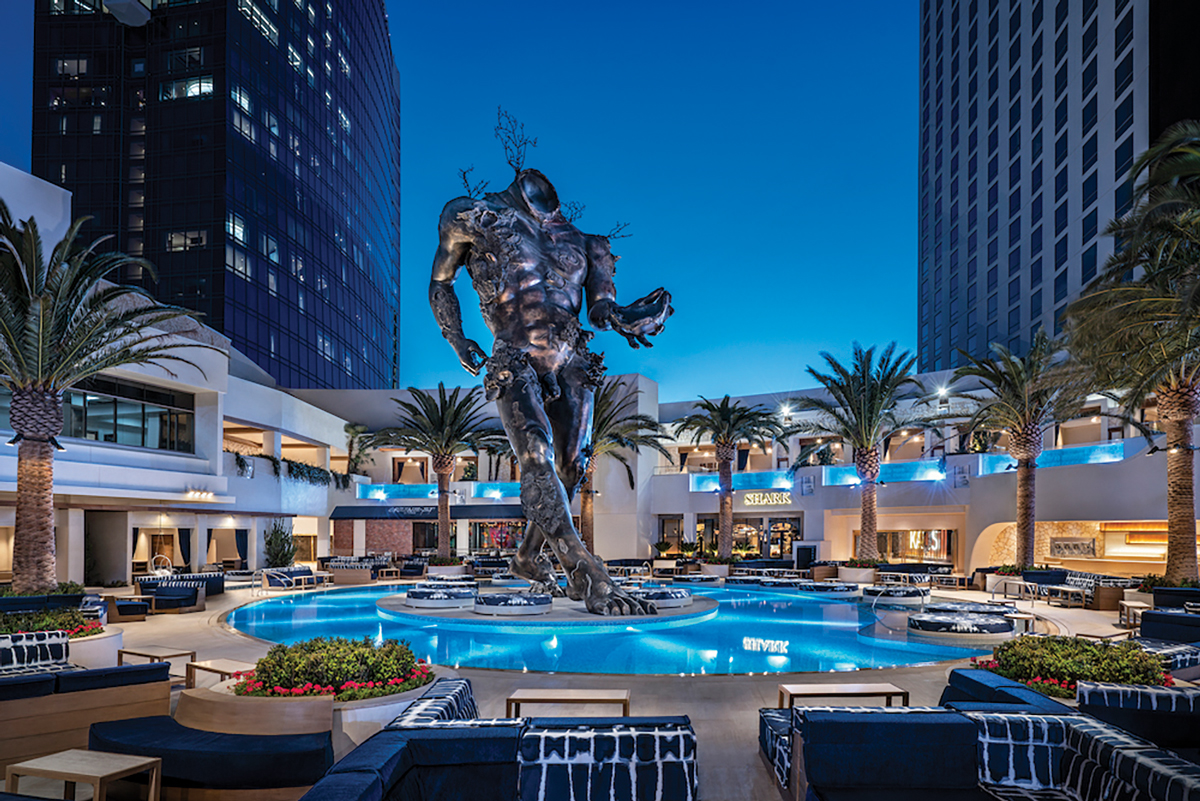
Damien Hirst’s Demon with Bowl debuted in a 2017 solo show at the Palazzo Grassi, one of French mega-collector François Pinault’s private museums in Venice. The Fertitta brothers, major collectors in their own right, scooped up the work and installed it at the Palms Casino.
COURTESY THE PALMS
The Fertitta family—best known for their stewardship of the Ultimate Fighting Championship, which they sold in 2017 for $4 billion—added a suite designed by Damien Hirst that comes with its own sharks preserved in formaldehyde in their $690 million makeover of the Palms casino. An exhibition copy of Hirst’s 60-foot bronze figure, Demon with Bowl, was was the centerpiece of his 2017 show at the Palazzo Grassi, French megacollector François Pinault’s private museum in Venice, Italy; a bronze version, the first produced, now looms over the resort’s pools.
In March, Harmon moved back to her hometown from New York, where she had served as development director for the alternative venue Artists Space, to lead the effort to create the Nevada Museum of Art, Las Vegas.
“Now we’re the city that is growing into itself,” Harmon says, ticking off other recent Las Vegas cultural achievements, such as the Golden Knights, a new professional hockey team, and the rising stadium for the NFL Raiders, soon to be the Las Vegas Raiders. Art may be the final frontier for Las Vegas.
Many people also point to the Smith Center for the Performing Arts, home to the Las Vegas Philharmonic and the Nevada Ballet Theatre. It shares the site, dubbed Symphony Park, destined for the art museum, and it lends a fresh sense of purpose to the city’s downtown.
“I just felt there was an energy in Vegas that I hadn’t felt before,” says Katie O’Neill, a trustee and chairman of the committee to bring the Nevada Museum of Art to Las Vegas.
O’Neill is another prodigal who left for New York, then returned. Her notorious great-grandfather, Benny Binion, famously arrived from Texas with his family and a suitcase full of cash in the trunk of his car, then built Binion’s casino—where card counters were said to be taken into the alley to learn their lesson—and established the famous Binion’s World Series of Poker. O’Neill worked in the casino as a teenager.
Now focused on the arts, she served on the Seven Magic Mountains committee, which overcame significant local opposition. When it opened in 2016, says Walker, “Very few people in Las Vegas saw the merit or the potential.”
“We’ve made a lot of progress,” says O’Neill. “We’ve got a lot more progress to make.”
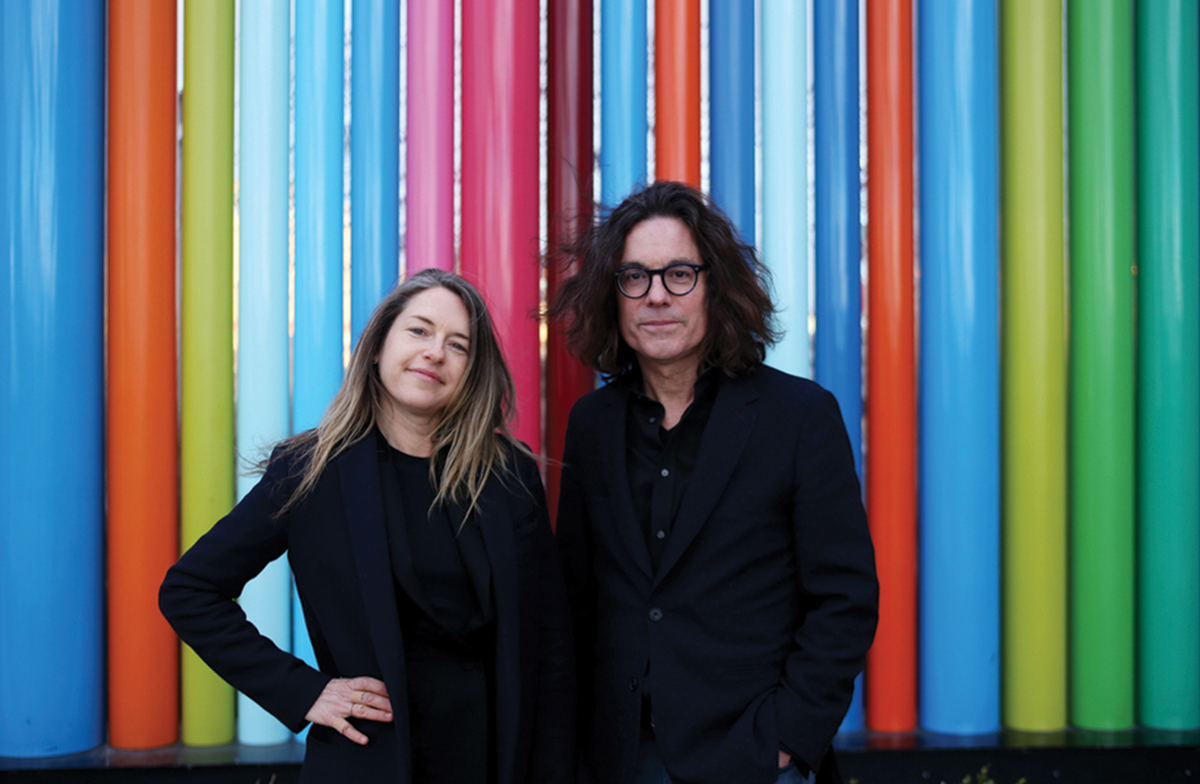
Heather Harmon and David Walker are looking to bring a branch of the Nevada Museum of Art in Reno to Las Vegas.
COURTESY NEVADA MUSEUM OF ART IN RENO
Estimates are that the Las Vegas museum will need to raise at least $250 million before it can become a reality in five to seven years.
Deserts are chic these days, and increasingly alluring to modern counterculture and art circles. Desert X, a scavenger hunt for art by the likes of Mary Kelly, Sterling Ruby, and Jenny Holzer, this spring had its second go-round in the Coachella Valley near Palm Springs. The Bombay Beach Biennale in the Southern California desert is a kooky art festival that shares rebellious DNA with Burning Man, which itself was the subject of an exhibition at the Renwick Gallery in Washington, D.C.
The mid-century sprawl of Palm Springs has become chic with the return of interest in modern design, and other regional American cities are benefiting from being seen as livable, affordable, and culturally relevant. Austin, Texas; Mesa, Arizona; and Raleigh, North Carolina, sit atop best-cities-to-live-in lists.
Early Las Vegas neighborhoods share the mid-century-modern desert essence of Palm Springs, with the added boost of Nevada’s having no personal income tax. Many transplants, who arrive with expectations of access to art and culture from their last city, are shunning the ’80s and ’90s suburbs and instead planting their flags in the early Vegas suburbs whose ranch houses and kidney-shaped pools look Dwell magazine ready. The home of the late Tony “The Ant” Spilotro—the gangster played by Joe Pesci in Martin Scorsese’s film Casino, 1995—recently sold within a week for a relatively modest asking price of $419,900. Harmon bought a home in the Paradise Palms neighborhood and reports that neighbors hold monthly “socials” that move from house to house.
A downtown art scene is burgeoning. Brent Holmes, a local artist whose father, Clint Holmes, is a Las Vegas entertainer, has been emceeing performance art nights downtown at the behest of UNLV Art Department chairman Marcus Civin. He looks forward to the possibility of a Las Vegas art fair or gallery economy. “Even five years ago, the conversation was, how do I get out of Las Vegas?” he says. Sticking around offers advantages. “I refer to Las Vegas as a failure-free city. Nobody’s watching so you can try your crazy ideas,” he says.
Plans for the Las Vegas museum remain fuzzy. There’s the land on offer from the city, if the Nevada Museum can raise a relatively easy-to-reach $12 million in matching funds. There are as yet no clear plans for what would be on display. But Harmon is talking multicultural and multidimensional art: aboriginal, Native American, Hispanic, and African-American works that would reflect the diverse Las Vegas population. “You come for something with a contemporary art point of view and you leave with Paiute Indians,” she says. “We want to be adventurous in our programming.”
Her personal dream is to bring in an exhibition by wordsmith artist Jenny Holzer. “We’re going to be able to shift how people think about our city. It inspired me to move home,” says Harmon. “The desert really pulses through your veins. I love Las Vegas.”
A version of this story originally appeared in the Summer 2019 issue of ARTnews on page 80 under the title “Betting Big
on Art.”
[ad_2]
Source link

